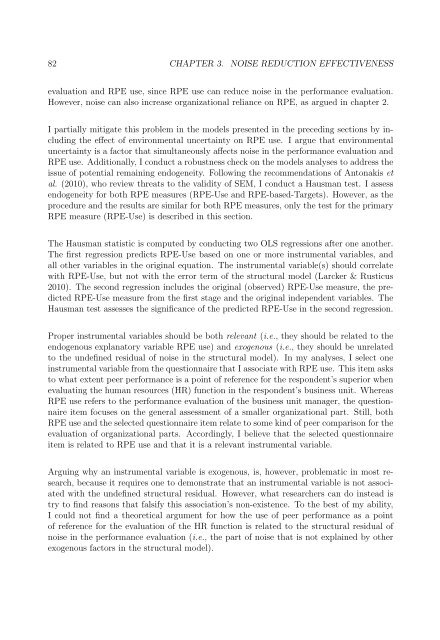pdf - Nyenrode Business Universiteit
pdf - Nyenrode Business Universiteit
pdf - Nyenrode Business Universiteit
Create successful ePaper yourself
Turn your PDF publications into a flip-book with our unique Google optimized e-Paper software.
82 CHAPTER 3. NOISE REDUCTION EFFECTIVENESS<br />
evaluation and RPE use, since RPE use can reduce noise in the performance evaluation.<br />
However, noise can also increase organizational reliance on RPE, as argued in chapter 2.<br />
I partially mitigate this problem in the models presented in the preceding sections by including<br />
the effect of environmental uncertainty on RPE use. I argue that environmental<br />
uncertainty is a factor that simultaneously affects noise in the performance evaluation and<br />
RPE use. Additionally, I conduct a robustness check on the models analyses to address the<br />
issue of potential remaining endogeneity. Following the recommendations of Antonakis et<br />
al. (2010), who review threats to the validity of SEM, I conduct a Hausman test. I assess<br />
endogeneity for both RPE measures (RPE-Use and RPE-based-Targets). However, as the<br />
procedure and the results are similar for both RPE measures, only the test for the primary<br />
RPE measure (RPE-Use) is described in this section.<br />
The Hausman statistic is computed by conducting two OLS regressions after one another.<br />
The first regression predicts RPE-Use based on one or more instrumental variables, and<br />
all other variables in the original equation. The instrumental variable(s) should correlate<br />
with RPE-Use, but not with the error term of the structural model (Larcker & Rusticus<br />
2010). The second regression includes the original (observed) RPE-Use measure, the predicted<br />
RPE-Use measure from the first stage and the original independent variables. The<br />
Hausman test assesses the significance of the predicted RPE-Use in the second regression.<br />
Proper instrumental variables should be both relevant (i.e., they should be related to the<br />
endogenous explanatory variable RPE use) and exogenous (i.e., they should be unrelated<br />
to the undefined residual of noise in the structural model). In my analyses, I select one<br />
instrumental variable from the questionnaire that I associate with RPE use. This item asks<br />
to what extent peer performance is a point of reference for the respondent’s superior when<br />
evaluating the human resources (HR) function in the respondent’s business unit. Whereas<br />
RPE use refers to the performance evaluation of the business unit manager, the questionnaire<br />
item focuses on the general assessment of a smaller organizational part. Still, both<br />
RPE use and the selected questionnaire item relate to some kind of peer comparison for the<br />
evaluation of organizational parts. Accordingly, I believe that the selected questionnaire<br />
item is related to RPE use and that it is a relevant instrumental variable.<br />
Arguing why an instrumental variable is exogenous, is, however, problematic in most research,<br />
because it requires one to demonstrate that an instrumental variable is not associated<br />
with the undefined structural residual. However, what researchers can do instead is<br />
try to find reasons that falsify this association’s non-existence. To the best of my ability,<br />
I could not find a theoretical argument for how the use of peer performance as a point<br />
of reference for the evaluation of the HR function is related to the structural residual of<br />
noise in the performance evaluation (i.e., the part of noise that is not explained by other<br />
exogenous factors in the structural model).
















